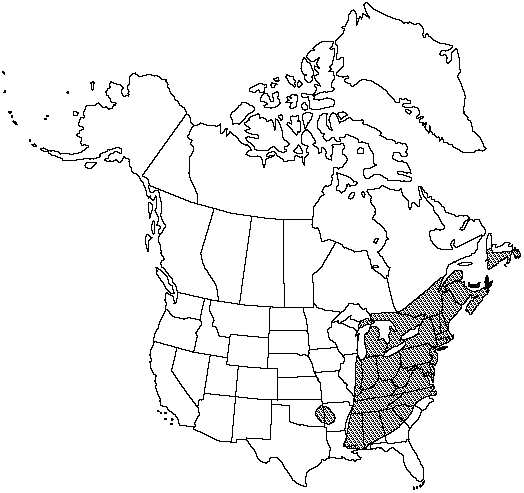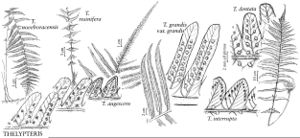FNA>Volume Importer |
FNA>Volume Importer |
| Line 29: |
Line 29: |
| | }}<!-- | | }}<!-- |
| | | | |
| − | --><span class="statement" id="st-d0_s0" data-properties="stem growth form or orientation;stem diameter"><b>Stems </b>usually long-creeping, 1.5–2.5 mm diam.</span> <span class="statement" id="st-d0_s1" data-properties="leaf architecture;leaf condition;leaf arrangement;leaf some measurement;leaf atypical some measurement;leaf some measurement"><b>Leaves </b>monomorphic, dying back in winter, mostly evenly spaced 1 cm or more (sun-gathering leaves in loose cluster), (25–) 40–85 cm.</span> <span class="statement" id="st-d0_s2" data-properties="petiole coloration;petiole length;petiole width;petiole shape;petiole pubescence;scale coloration;scale coloration;scale coloration"><b>Petiole </b>straw-colored, 4–25 cm × 1–3 mm, at base with scales tan to reddish-brown, ovate, glabrous.</span> <span class="statement" id="st-d0_s3" data-properties="blade arrangement or shape;blade some measurement;blade position;blade count;pinna size;blade shape;apex shape"><b>Blade </b>elliptic, 15–60 cm, proximal 4–10 pinna pairs gradually smaller toward base (smallest often less than 5 mm), blade tapering gradually to pinnatifid apex.</span> <span class="statement" id="st-d0_s4" data-properties="pinna shape;pinna atypical length;pinna length;pinna atypical width;pinna width"><b>Pinnae </b>deeply pinnatifid to within 1 mm of costa, 3–9 (–13) × 1–2 (–2.5) cm;</span> <span class="statement" id="st-d0_s5" data-properties="segment shape;segment shape;segment shape;segment shape;segment shape;segment shape;segment shape">segments oblong to linear, somewhat oblique, entire to crenulate;</span> <span class="statement" id="st-d0_s6" data-properties="segment arrangement">proximal pair of veins from adjacent segments meeting margin above sinus.</span> <span class="statement" id="st-d0_s7" data-properties="indument some measurement;gland count;gland count;gland architecture"><b>Indument </b>abaxially of moderately to densely set hairs to 1 mm on rachises, costae, and veins, glands lacking or yellowish to light orangish, mostly sessile on blade tissue;</span> <span class="statement" id="st-d0_s8" data-properties="">blades adaxially often with hairs on veins.</span> <span class="statement" id="st-d0_s9" data-properties="sorus shape;sorus position"><b>Sori </b>round, supramedial;</span> <span class="statement" id="st-d0_s10" data-properties="indusium coloration;indusium architecture or pubescence or shape">indusia tan, often ciliate;</span> <span class="statement" id="st-d0_s11" data-properties="">sporangia glabrous.</span> <span class="statement" id="st-d0_s12" data-properties="sporangium pubescence;2n chromosome count">2n = 54.</span><!-- | + | --><span class="statement" id="st-undefined" data-properties=""><b>Stems </b>usually long-creeping, 1.5–2.5 mm diam. <b>Leaves</b> monomorphic, dying back in winter, mostly evenly spaced 1 cm or more (sun-gathering leaves in loose cluster), (25–)40–85 cm. <b>Petiole</b> straw-colored, 4–25 cm × 1–3 mm, at base with scales tan to reddish brown, ovate, glabrous. <b>Blade</b> elliptic, 15–60 cm, proximal 4–10 pinna pairs gradually smaller toward base (smallest often less than 5 mm), blade tapering gradually to pinnatifid apex. <b>Pinnae</b> deeply pinnatifid to within 1 mm of costa, 3–9(–13) × 1–2(–2.5) cm; segments oblong to linear, somewhat oblique, entire to crenulate; proximal pair of veins from adjacent segments meeting margin above sinus. <b>Indument</b> abaxially of moderately to densely set hairs to 1 mm on rachises, costae, and veins, glands lacking or yellowish to light orangish, mostly sessile on blade tissue; blades adaxially often with hairs on veins. <b>Sori</b> round, supramedial; indusia tan, often ciliate; sporangia glabrous. <b>2n</b> = 54.</span><!-- |
| | | | |
| | -->{{Treatment/Body | | -->{{Treatment/Body |
| Line 57: |
Line 57: |
| | |publication year=1910 | | |publication year=1910 |
| | |special status= | | |special status= |
| − | |source xml=https://jpend@bitbucket.org/aafc-mbb/fna-fine-grained-xml.git/src/287ef3db526bd807d435a3c7423ef2df1e951227/V2/V2_207.xml | + | |source xml=https://jpend@bitbucket.org/aafc-mbb/fna-data-curation.git/src/9216fc802291cd3df363fd52122300479582ede7/coarse_grained_fna_xml/V2/V2_207.xml |
| | |genus=Thelypteris | | |genus=Thelypteris |
| | |subgenus=Thelypteris subg. Parathelypteris | | |subgenus=Thelypteris subg. Parathelypteris |
| | |species=Thelypteris noveboracensis | | |species=Thelypteris noveboracensis |
| − | |2n chromosome count=54
| |
| − | |apex shape=pinnatifid
| |
| − | |blade arrangement or shape=elliptic
| |
| − | |blade count=4;10
| |
| − | |blade position=proximal
| |
| − | |blade shape=tapering
| |
| − | |blade some measurement=15cm;60cm
| |
| − | |gland architecture=sessile
| |
| − | |gland count=yellowish to light orangish;lacking
| |
| − | |indument some measurement=0mm;1mm
| |
| − | |indusium architecture or pubescence or shape=ciliate
| |
| − | |indusium coloration=tan
| |
| − | |leaf architecture=monomorphic
| |
| − | |leaf arrangement=spaced
| |
| − | |leaf atypical some measurement=25cm;40cm
| |
| − | |leaf condition=dying
| |
| − | |leaf some measurement=40cm;85cm
| |
| − | |petiole coloration=straw-colored
| |
| − | |petiole length=4cm;25cm
| |
| − | |petiole pubescence=glabrous
| |
| − | |petiole shape=ovate
| |
| − | |petiole width=1mm;3mm
| |
| − | |pinna atypical length=9cm;13cm
| |
| − | |pinna atypical width=2cm;2.5cm
| |
| − | |pinna length=3cm;9cm
| |
| − | |pinna shape=pinnatifid
| |
| − | |pinna size=smaller
| |
| − | |pinna width=1cm;2cm
| |
| − | |scale coloration=tan;reddish-brown
| |
| − | |segment arrangement=adjacent
| |
| − | |segment shape=entire;crenulate
| |
| − | |sorus position=supramedial
| |
| − | |sorus shape=round
| |
| − | |sporangium pubescence=glabrous
| |
| − | |stem diameter=1.5mm;2.5mm
| |
| − | |stem growth form or orientation=long-creeping
| |
| | }}<!-- | | }}<!-- |
| | | | |
| | -->[[Category:Treatment]][[Category:Thelypteris subg. Parathelypteris]] | | -->[[Category:Treatment]][[Category:Thelypteris subg. Parathelypteris]] |
Stems usually long-creeping, 1.5–2.5 mm diam. Leaves monomorphic, dying back in winter, mostly evenly spaced 1 cm or more (sun-gathering leaves in loose cluster), (25–)40–85 cm. Petiole straw-colored, 4–25 cm × 1–3 mm, at base with scales tan to reddish brown, ovate, glabrous. Blade elliptic, 15–60 cm, proximal 4–10 pinna pairs gradually smaller toward base (smallest often less than 5 mm), blade tapering gradually to pinnatifid apex. Pinnae deeply pinnatifid to within 1 mm of costa, 3–9(–13) × 1–2(–2.5) cm; segments oblong to linear, somewhat oblique, entire to crenulate; proximal pair of veins from adjacent segments meeting margin above sinus. Indument abaxially of moderately to densely set hairs to 1 mm on rachises, costae, and veins, glands lacking or yellowish to light orangish, mostly sessile on blade tissue; blades adaxially often with hairs on veins. Sori round, supramedial; indusia tan, often ciliate; sporangia glabrous. 2n = 54.
Habitat: Terrestrial in moist woods, especially near swamps, streams, and in vernal seeps of ravines, often in slightly disturbed secondary forests, frequently forming large colonies
Elevation: 0–1100 m
Distribution
St. Pierre and Miquelon, N.B., Nfld., N.S., Ont., P.E.I., Que., Ala., Ark., Conn., Del., D.C., Ga., Ill., Ind., Ky., La., Maine, Md., Mass., Mich., Miss., N.H., N.J., N.Y., N.C., Ohio, Okla., Pa., R.I., S.C., Tenn., Vt., Va., W.Va.
Discussion
Selected References
None.

